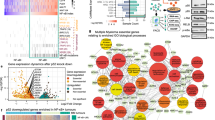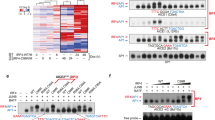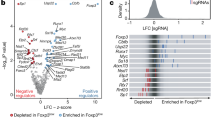Abstract
The transcription factor IRF4 (interferon regulatory factor 4) is required during an immune response for lymphocyte activation and the generation of immunoglobulin-secreting plasma cells1,2,3. Multiple myeloma, a malignancy of plasma cells, has a complex molecular aetiology with several subgroups defined by gene expression profiling and recurrent chromosomal translocations4,5. Moreover, the malignant clone can sustain multiple oncogenic lesions, accumulating genetic damage as the disease progresses6,7. Current therapies for myeloma can extend survival but are not curative8,9. Hence, new therapeutic strategies are needed that target molecular pathways shared by all subtypes of myeloma. Here we show, using a loss-of-function, RNA-interference-based genetic screen, that IRF4 inhibition is toxic to myeloma cell lines, regardless of transforming oncogenic mechanism. Gene expression profiling and genome-wide chromatin immunoprecipitation analysis uncovered an extensive network of IRF4 target genes and identified MYC as a direct target of IRF4 in activated B cells and myeloma. Unexpectedly, IRF4 was itself a direct target of MYC transactivation, generating an autoregulatory circuit in myeloma cells. Although IRF4 is not genetically altered in most myelomas, they are nonetheless addicted to an aberrant IRF4 regulatory network that fuses the gene expression programmes of normal plasma cells and activated B cells.
This is a preview of subscription content, access via your institution
Access options
Subscribe to this journal
Receive 51 print issues and online access
$199.00 per year
only $3.90 per issue
Buy this article
- Purchase on SpringerLink
- Instant access to full article PDF
Prices may be subject to local taxes which are calculated during checkout





Similar content being viewed by others
References
Mittrucker, H. W. et al. Requirement for the transcription factor LSIRF/IRF4 for mature B and T lymphocyte function. Science 275, 540–543 (1997)
Klein, U. et al. Transcription factor IRF4 controls plasma cell differentiation and class-switch recombination. Nature Immunol. 7, 773–782 (2006)
Sciammas, R. et al. Graded expression of interferon regulatory factor-4 coordinates isotype switching with plasma cell differentiation. Immunity 25, 225–236 (2006)
Zhan, F. et al. The molecular classification of multiple myeloma. Blood 108, 2020–2028 (2006)
Bergsagel, P. L. et al. Promiscuous translocations into immunoglobulin heavy chain switch regions in multiple myeloma. Proc. Natl Acad. Sci. USA 93, 13931–13936 (1996)
Kuehl, W. M. & Bergsagel, P. L. Multiple myeloma: evolving genetic events and host interactions. Nature Rev. Cancer 2, 175–187 (2002)
Carrasco, D. R. et al. High-resolution genomic profiles define distinct clinico-pathogenetic subgroups of multiple myeloma patients. Cancer Cell 9, 313–325 (2006)
Barlogie, B. et al. Treatment of multiple myeloma. Blood 103, 20–32 (2004)
Mitsiades, C. S., Mitsiades, N., Munshi, N. C. & Anderson, K. C. Focus on multiple myeloma. Cancer Cell 6, 439–444 (2004)
Ngo, V. N. et al. A loss-of-function RNA interference screen for molecular targets in cancer. Nature 441, 106–110 (2006)
Davis, R. E., Brown, K. D., Siebenlist, U. & Staudt, L. M. Constitutive nuclear factor κB activity is required for survival of activated B cell-like diffuse large B cell lymphoma cells. J. Exp. Med. 194, 1861–1874 (2001)
Subramanian, A. et al. Gene set enrichment analysis: A knowledge-based approach for interpreting genome-wide expression profiles. Proc. Natl Acad. Sci. USA 102, 15545–15550 (2005)
Gutierrez, N. C. et al. Gene expression profiling of B lymphocytes and plasma cells from Waldenstrom’s macroglobulinemia: comparison with expression patterns of the same cell counterparts from chronic lymphocytic leukemia, multiple myeloma and normal individuals. Leukemia 21, 541–549 (2007)
Tamura, T. et al. IFN regulatory factor-4 and -8 govern dendritic cell subset development and their functional diversity. J. Immunol. 174, 2573–2581 (2005)
Su, A. I. et al. A gene atlas of the mouse and human protein-encoding transcriptomes. Proc. Natl Acad. Sci. USA 101, 6062–6067 (2004)
Shou, Y. et al. Diverse karyotypic abnormalities of the c-myc locus associated with c-myc dysregulation and tumor progression in multiple myeloma. Proc. Natl Acad. Sci. USA 97, 228–233 (2000)
Zeller, K. I. et al. Global mapping of c-Myc binding sites and target gene networks in human B cells. Proc. Natl Acad. Sci. USA 103, 17834–17839 (2006)
Guney, I., Wu, S. & Sedivy, J. M. Reduced c-Myc signaling triggers telomere-independent senescence by regulating Bmi-1 and p16INK4a. Proc. Natl Acad. Sci. USA 103, 3645–3650 (2006)
Kim, J. W., Gao, P., Liu, Y. C., Semenza, G. L. & Dang, C. V. HIF-1 and dysregulated c-Myc cooperatively induces VEGF and metabolic switches, HK2 and PDK1. Mol Cell Biol 27, 7381–7393 (2007)
Dang, C. V. et al. The c-Myc target gene network. Semin. Cancer Biol. 16, 253–264 (2006)
Dib, A., Gabrea, A., Glebov, O., Bergsagel, P. L. & Kuehl, W. M. Characterization of MYC translocations in multiple myeloma cell lines. J. Natl Cancer Inst. (in the press)
Liu, J. & Levens, D. Making myc. Curr. Top. Microbiol. Immunol. 302, 1–32 (2006)
Garraway, L. A. & Sellers, W. R. Lineage dependency and lineage-survival oncogenes in human cancer. Nature Rev. Cancer 6, 593–602 (2006)
Solimini, N. L., Luo, J. & Elledge, S. J. Non-oncogene addiction and the stress phenotype of cancer cells. Cell 130, 986–988 (2007)
Hauf, S. et al. Dissociation of cohesin from chromosome arms and loss of arm cohesion during early mitosis depends on phosphorylation of SA2. PLoS Biol. 3, e69 (2005)
Ge, H. & Roeder, R. G. Purification, cloning, and characterization of a human coactivator, PC4, that mediates transcriptional activation of class II genes. Cell 78, 513–523 (1994)
Vassilev, L. T. et al. In vivo activation of the p53 pathway by small-molecule antagonists of MDM2. Science 303, 844–848 (2004)
Polo, J. M. et al. Specific peptide interference reveals BCL6 transcriptional and oncogenic mechanisms in B-cell lymphoma cells. Nature Med. 10, 1329–1335 (2004)
Alizadeh, A. A. et al. Distinct types of diffuse large B-cell lymphoma identified by gene expression profiling. Nature 403, 503–511 (2000)
Acknowledgements
This research was supported by the Intramural Research Program of the National Institute of Health (NIH), National Cancer Institute, Center for Cancer Research. Y.Z., B.C. and J.E. were supported by NCI grants CA97513 and CA113992. We wish to thank K. Meyer for her assistance with GEO submissions; D. Levens, J. Liu and H.-J. Chung for assistance with MYC ChIP assay design and the MYC promoter-GFP reporter construct; K. Ozato and L. Ramakrishna for IRF4-deficient mice; and M. Kuehl and members of the Staudt laboratory for their assistance and discussions.
Author Contributions Experimental design/discussion, A.L.S., V.N.N., J.E. and L.M.S.; preparation and performance of experiments, A.L.S, N.C.T.E., L.L., V.N.N., S.D., X.Y., H.Z., Y.Z. and B.C.; data analysis/interpretation, A.L.S., N.C.T.E., W.X., G.W., J.P., J.E. and L.M.S.; manuscript preparation, A.L.S. and L.M.S.
Author information
Authors and Affiliations
Corresponding author
Supplementary information
Supplementary Methods
The file contains Supplementary Methods. (PDF 250 kb)
Supplementary Figures
The file contains Supplementary Figures 1-9 with Legends. (PDF 1271 kb)
Supplementary Tables
The file contains Supplementary Tables 1-3. (PDF 3661 kb)
Rights and permissions
About this article
Cite this article
Shaffer, A., Emre, N., Lamy, L. et al. IRF4 addiction in multiple myeloma. Nature 454, 226–231 (2008). https://doi.org/10.1038/nature07064
Received:
Accepted:
Published:
Issue Date:
DOI: https://doi.org/10.1038/nature07064



